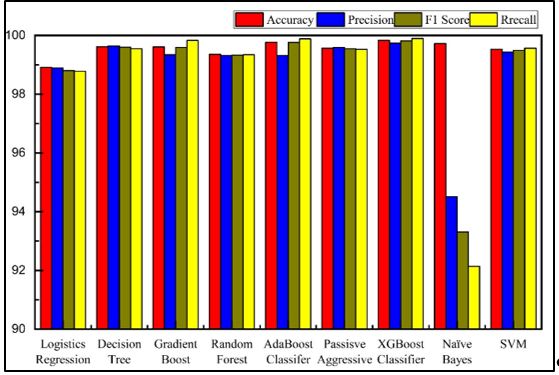Performance Evaluation of Fake News Detection Using Artificial Intelligence Techniques
Keywords:
Techniques, TD-IDF, Features, Artificial Techniques, True and Fake NewsAbstract
Introduction/Importance of Study: As the proliferation of fake news poses significant challenges to traditional fact-checking methods, there is a growing need for robust and automated approaches to combat misinformation.
Novelty statement: This study presents a comprehensive evaluation of artificial models for fake news detection, offering insights into their effectiveness and applicability in addressing the contemporary issue of misinformation.
Material and Method: The research employs various artificial algorithms, including logistic regression, gradient boosting, decision trees, random forest, AdaBoost, passive aggressive classification, XGBoost, naive Bayes, and support vector machines (SVM), to train datasets and evaluate the performance of each model.
Result and Discussion: Through rigorous evaluation, the study finds that XGBoost and AdaBoost classifiers exhibit the highest accuracy rates of 99.83% and 99.77%, respectively, in detecting fake news. Decision Tree, Support Vector Machine, and Gradient Boosting classifiers also demonstrate commendable performance. Conversely, the Naive Bayes classifier exhibits the lowest accuracy, suggesting its limitations in fake news detection.
Concluding Remarks: This research underscores the significance of ensemble methods such as XGBoost and AdaBoost in effectively identifying fake news, laying the groundwork for future advancements in combatting misinformation.
References
I. Ahmad, M. Yousaf, S. Yousaf, and M. O. Ahmad, “Fake News Detection Using Machine Learning Ensemble Methods,” Complexity, vol. 2020, no. 1, p. 8885861, Jan. 2020, doi: 10.1155/2020/8885861.
“Fake News Detection on Social Media: A Data Mining Perspective”, [Online]. Available: https://dl.acm.org/doi/10.1145/3137597.3137600
N. Kshetri and J. Voas Kshetri, “The Economics of "Fake News,” IEEE IT Prof., vol. 19, no. 6, pp. 8–12, 2017, doi: 10.1109/MITP.2017.4241459.
J. M. Fernandez, “Malaysia’s Anti-Fake News Act: A cog in an arsenal of anti-free speech laws and a bold promise of reforms,” Pacific Journal. Rev. Te Koakoa, vol. 25, no. 1&2, pp. 173–192, Jul. 2019, doi: 10.24135/PJR.V25I1.474.
T. Thate, “Using Natural Language Processing to Detect Fake News.” Jun. 22, 2021. Accessed: Jun. 15, 2024. [Online]. Available: https://www.academia.edu/82451181/Using_Natural_Language_Processing_to_Detect_Fake_News
D. S. Abdelminaam, F. H. Ismail, M. Taha, A. Taha, E. H. Houssein, and A. Nabil, “CoAID-DEEP: An Optimized Intelligent Framework for Automated Detecting COVID-19 Misleading Information on Twitter,” IEEE Access, vol. 9, pp. 27840–27867, 2021, doi: 10.1109/ACCESS.2021.3058066.
I. Ali, M. N. Bin Ayub, P. Shivakumara, and N. F. B. M. Noor, “Fake News Detection Techniques on Social Media: A Survey,” Wirel. Commun. Mob. Comput., vol. 2022, no. 1, p. 6072084, Jan. 2022, doi: 10.1155/2022/6072084.
“Fake News | Kaggle.” Accessed: Jun. 15, 2024. [Online]. Available: https://www.kaggle.com/c/fake-news/overview
L. Wu and H. Liu, “Tracing fake-news footprints: Characterizing social media messages by how they propagate,” WSDM 2018 - Proc. 11th ACM Int. Conf. Web Search Data Min., vol. 2018-Febuary, pp. 637–645, Feb. 2018, doi: 10.1145/3159652.3159677.
“Preprocessing Techniques for Text Mining - An Overview.” Accessed: Jun. 15, 2024. [Online]. Available: https://www.researchgate.net/publication/339529230_Preprocessing_Techniques_for_Text_Mining_-_An_Overview
A. Kathuria, A. Gupta, and R. K. Singla, “A Review of Tools and Techniques for Preprocessing of Textual Data,” Adv. Intell. Syst. Comput., vol. 1227, pp. 407–422, 2021, doi: 10.1007/978-981-15-6876-3_31.
“Text Mining: Use of TF-IDF to Examine the Relevance of Words to Documents.” Accessed: Jun. 15, 2024. [Online]. Available: https://www.ijcaonline.org/archives/volume181/number1/qaiser-2018-ijca-917395.pdf
“BINARY LOGISTIC REGRESSION BASED CLASSIFIER FOR FAKE NEWS | Journal of Higher Education Research Disciplines.” Accessed: Jun. 15, 2024. [Online]. Available: https://www.nmsc.edu.ph/ojs/index.php/jherd/article/view/98
S. Lyu and D. C. T. Lo, “Fake News Detection by Decision Tree,” Conf. Proc. - IEEE SOUTHEASTCON, vol. 2020-March, Mar. 2020, doi: 10.1109/SOUTHEASTCON44009.2020.9249688.
S. Selva Birunda and R. Kanniga Devi, “A Novel Score-Based Multi-Source Fake News Detection using Gradient Boosting Algorithm,” Proc. - Int. Conf. Artif. Intell. Smart Syst. ICAIS 2021, pp. 406–414, Mar. 2021, doi: 10.1109/ICAIS50930.2021.9395896.
B. Gregorutti, B. Michel, and P. Saint-Pierre, “Correlation and variable importance in random forests,” Stat. Comput., vol. 27, no. 3, pp. 659–678, May 2017, doi: 10.1007/S11222-016-9646-1/METRICS.
L. Holla and K. S. Kavitha, “An Improved Fake News Detection Model Using Hybrid Time Frequency-Inverse Document Frequency for Feature Extraction and AdaBoost Ensemble Model as a Classifier,” J. Adv. Inf. Technol., vol. 15, no. 2, pp. 202–211, 2024, doi: 10.12720/JAIT.15.2.202-211.
S. Gupta and P. Meel, “Fake News Detection Using Passive-Aggressive Classifier,” Lect. Notes Networks Syst., vol. 145, pp. 155–164, 2021, doi: 10.1007/978-981-15-7345-3_13.
J. P. Haumahu, S. D. H. Permana, and Y. Yaddarabullah, “Fake news classification for Indonesian news using Extreme Gradient Boosting (XGBoost),” IOP Conf. Ser. Mater. Sci. Eng., vol. 1098, no. 5, p. 052081, Mar. 2021, doi: 10.1088/1757-899X/1098/5/052081.
A. J. S. T. Hofmann, B. Schölkopf, “Kernel methods in machine learning,” 2008.
N. Cristianini and J. Shawe-Taylor, “An Introduction to Support Vector Machines and Other Kernel-based Learning Methods,” An Introd. to Support Vector Mach. Other Kernel-based Learn. Methods, Mar. 2000, doi: 10.1017/CBO9780511801389.
F. K. ; Alarfaj, J. A. Khan, F. Khaled Alarfaj, and J. A. Khan, “Deep Dive into Fake News Detection: Feature-Centric Classification with Ensemble and Deep Learning Methods,” Algorithms 2023, Vol. 16, Page 507, vol. 16, no. 11, p. 507, Nov. 2023, doi: 10.3390/A16110507.

Downloads
Published
How to Cite
Issue
Section
License
Copyright (c) 2024 International Journal of Innovations in Science & Technology

This work is licensed under a Creative Commons Attribution 4.0 International License.




















